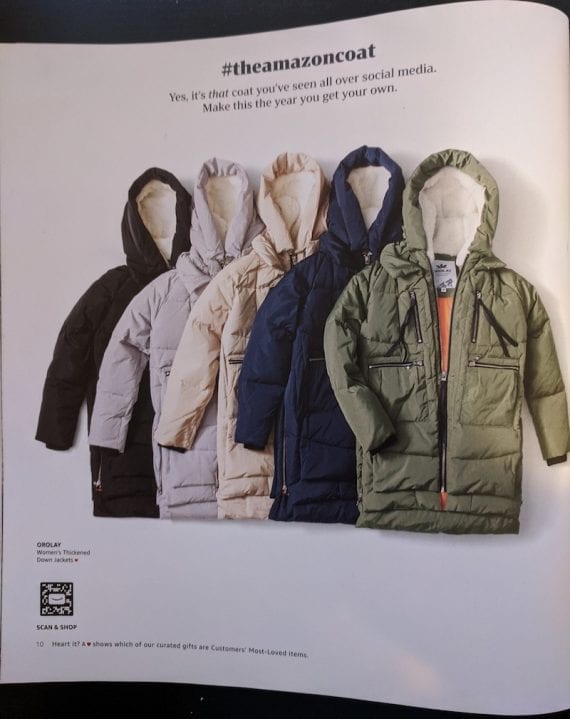A few days back I received a surprise in the mail courtesy of Amazon: a 2019 gift catalog titled “Holiday Together.” I recognized the Amazon smile logo at the bottom of the cover, which piqued my curiosity. I opened the catalog and turned the pages.

Amazon’s 2019 printed gift catalog is titled “Holiday Together.”
My curiosity became stronger because the catalog listed no prices alongside the products. Here’s a page featuring “the Amazon coat.”

The catalog contains no prices.
Amazon demonstrated its social media savvy by including the hashtag at the top of the page — #theamazoncoat — but, again, the page contained no pricing.
The catalog included some compelling examples of product curation. Note the winter clothing collection, below. It has everything from hat to shoes to a wireless charging battery case for a phone. The only surprise is the ax at the bottom. It isn’t available for purchase.

The winter clothing page has multiple curated items.
But it all begs a larger question: What is Amazon’s goal with this catalog?
Driving Demand
I manage pay-per-click advertising for companies large and small. It often requires reminding clients about demand generation and demand harvesting. With PPC ads on a Google search results page, we’re trying to harvest consumers’ existing demand. That is why they’re searching.
Mass-media branding campaigns such as television commercials or billboards generate demand, as do social media and display ads. An advertiser puts forth a message or product to raise awareness and thus generate demand.
Amazon’s “Holiday Together” catalog will increase demand for its products. Below the product images are brand and item names. The inside cover explains how a reader can purchase.
- Through the Amazon app. Each page has a “smile” QR code in the bottom left corner. This can be scanned in the Amazon app to bring up a list of all the products featured on that page.
- Through the vanity URL. Access amazon.com/holidaytogether to see all products in the catalog.
The vanity URL is the closest thing to a traditional call-to-action in the catalog.
But there is a third way that readers can purchase products, which the catalog doesn’t mention: searching for products directly on Amazon.
Amazon Ads
Amazon’s product-based search engine is massive. And Amazon has aggressively monetized search for the past few years. Amazon generated $3 billion in advertising revenue in the second quarter of 2019. That doesn’t compare to Google Ads’ $32.6 billion of ad revenue in that quarter, but it’s a big chunk to add to Amazon’s other revenue streams.
Hence Amazon sends the catalogs. Consumers read them and see desirable products. They go to Amazon.com and search for, say, “the Amazon coat,” which produces a page as follows.

Searching for “the Amazon coat” produces three “Sponsored” ads and one “Best Seller.” Click image to enlarge.
Notice that the page features three “Sponsored” listings. None of these are for the coat pictured. But the “Best Seller” coat description (the Orolay down jacket) does align with the photo above it. While it has a pretty good idea that the searcher wants the “Best Seller” item, Amazon can also sell a click to the three “Sponsored” advertisers.
And if an advertiser sells a coat from that click, it will pay Amazon’s commissions and, if applicable, Amazon’s fulfillment and storage fees.
Generating Demand
Amazon famously reinvests profits for the sake of growth. But why would a massive ecommerce site print and mail a catalog?
To make money.
Amazon is willing to generate demand. Sure, some catalog readers will search on Google or Bing and click a result. But most will go to Amazon.com or the mobile app and search for products. That will lead to ad clicks and to sales of Amazon’s private label products and those of third-party sellers. All of those activities generate revenue.
Thus Amazon reminds us that generating demand can be as important as harvesting it. And you might want to give Amazon advertising a try.




